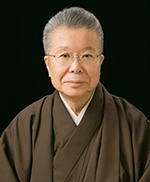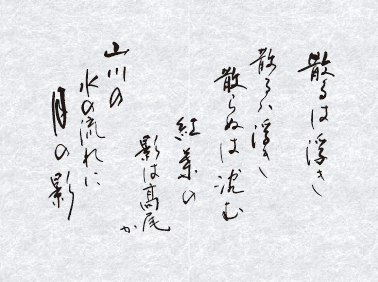Ko-uta
Introduction

Toshiaki Harutake
We have various kinds of traditional music created from time immemorial in each culture area and they have been passed down generation by generation. Ko-uta - literally short song - is one of Japanese traditional lyric song passed down through oral tradition since mid Edo period. Ko-uta must create a certain atmosphere in few words, so they tend to be dense in the sense that many images may be evoked with well-chosen phrases. So that it is sometimes likened to Haiku or Tanka because of its pithiness.
What's KO-UTA?
There are two grouping of Japanese traditional song accompanied by Shamisen (a fretless, long-necked, three-stringed instrument), Utaimono (lyrical shamisen music) and Katarimono (narrative shamisen music, ex; Tokiwazu and Kiyomoto) and Ko-uta is classified into Utaimono group like Naga-uta (long song). Most Ko-uta may be sung in less than minute, even longer ones taking three to four minutes at most. Ko-uta has been improvised by Katarimono player out of mere caprice and its theme has picked from many sources ranging from refined aestheticism to earthy humor and expresses the sentiments and/or romantic atmosphere of sophisticated Edo city dwellers. In singing Ko-uta, voice and instrument take two separate threads of sound and interval, weaving them together like a duet. The shamisen gives a note of a phrase, leading voice music part, and it is the complicated timing and skillful juxtaposition of shamisen and voice which is appreciated.
Edo-Kouta −Oyou’s Kouta−

The song is made by Oyou, the daughter of Kiyomoto Enjyudayu II who was the founder of Edo-Kouta. player : Sui Motoki I (1888~1979)
“Chiru wa uki”
“Chiru wa uki Chiranu wa shizumu
Momijiba no Kage wa Takao ka Yamakawa no
Kawa no Nagare ni Tsuki no Kage”
History of KO-UTA
History of short lyric Utaimono song goes back to Heian era, more than 1000 years ago. Then the roots of Ko-uta, Kyogen Ko-uta was born in Muromachi era which was 500-600 years ago and Ryutatsu-bushi was created in the beginning of Edo era. In mid Edo era, popular lyrics or folk songs started to sing accompanied by Shamisen, the original form of which was imported in Japan around 16th century, in Western Region - Kyoto to Osaka area - and those songs were gradually came down to Edo city. By late Edo era, those western rooted songs and folk songs ware all called Ha-uta and became very popular in Edo city. Then some Ha-uta songs were sung in tasteful slower tempo with grace and this way of sing Ha-uta was named Uta-zawa and became very popular among people of well-cultivated tastes. Little after Uta-zawa was born, there was another trend to sing Ha-uta in crispy tempo with refinement and this type of song became Edo Ko-uta, prototype of Ko-uta now we sing. Ko-uta was affected by Western Ha-uta taste at first. But later, a genius girl Oyou arranged a Tanka for the Ko-uta and this song Chiru wa Uki was recognized as the first original Edo Ko-uta. Since then, original Edo Ko-uta was gradually created by her, her husband Kiyomoto Enjudayu the fourth and other member of Kiyomoto group and the musical form Ko-uta as we hear it now was set. Then, Edo Ko-uta attained great popularity overshadowing Ha-uta and Uta-zawa styles as time goes and more songs has been created by new sources like Tokiwazu, Naga-uta, and other traditional Japanese music player since.
Chronology

KO-UTA FAQ
About KO-UTA
A: Hauta were the songs that were popular among the common people around Edo, during the mid Edo-period, which became the base of Kouta. The sound of the samisen in Hauta is larger and flashier than Kouta, because it is played by using the plectrum instead of plucking the strings by hand, although the actual music is not really very different. In the late Edo-period, after Utazawa-Bushi (Slow tempo compared to Hauta) developed out of Hauta, Kouta was created by a woman named Kiyomoto Oyo, who was a performer in the Kiyomoto style. The characteristic of Kouta is that the base of the song is fast tempo compared to Hauta and Utazawa, and the rhythms are Edo style, fast tempo too, which raised sympathy at that time. This is called Edo Kouta today.
A: Think of Joruri as the general term of Samisen Music’s Katarimono, which are songs with a story. The history goes way back to the 15th century. Compared to Joruri, Kouta is Utaimono. Utaimono are songs that include emotions of men and women.
A: First of all, the song of Kouta is very short. In the short song, class and chic is included expressing people’s emotion which is quite unique from others type of songs. This type of music suits today’s fast tempo living. When you have the chance, please listen to it.
A: In the beginning, Oyou’s Edo-Kouta used the plectrum to play like other Samisen Music. In the mid Meiji-period, the style of playing the Samisen changed from using the plectrum to finger plucking. This is because Kouta was performed not on a stage but as informal entertainment at dinner parties in small receptions halls. Therefore, playing the Samisen with the plectrum at late hours was hesitated. Also at the core, Kouta wanted a differentiation from other styles. The Edo-Kouta’s finger plucking advanced its tone to a soft touch and artistic one, opening a new field.
About Lessons
A: Please place an inquiry to info@kouta-renmei.org
A: Yes, of course. Both men and women are welcome.
A: It is not impossible, but in Samisen music, the balance of the song and Samisen is important, therefore, we recommend you to learn the songs first.
A: Basically the general rule is to have a one-to-one lesson. However, at some Culture Centers, there are places where group lesson are held.
A: It differs by teachers, but it seems that most classes have 4 lessons per month.
A: An average tuition starts from about 10,000 yen per month. (When enrolling to a class, an admission fee occurs. Standard admission fee is about one month worth of tuition.)
A: Think of it as the same as school or other classes. Even if you miss a class, you need to pay tuition. When you are taking a long break, it will be best that you talk to your teacher.
A: There is no dress code during lessons. If you are interested in wearing a kimono, there are opportunities to wear one.
A: If you are not used to seiza or you cannot sit in a seiza position, there are other ways to sit, so you should talk to your teacher.
Listen Now
Contact Us
A corporation aggregate
Japan Kouta Renmei
203 Kamps,
1-10-6 Yakumo, Meguro-ku, Tokyo, Japan 152-0023
info@kouta-renmei.org
